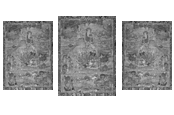
Item: Teacher (Lama) - Milarepa
| Origin Location | Tibet |
|---|---|
| Date Range | 1700 - 1799 |
| Lineages | Gelug and Buddhist |
| Size | 107.50x63.50cm (42.32x25in) |
| Material | Ground Mineral Pigment on Cotton |
| Collection | Nyingjei Lam |
Milarepa (mi la ras pa, 1040-1123): the great poet yogi of Tibet surrounded by life story vignettes.
The composition is in a Chamdo painting style dating to the late 18th or early 19th century. The name of the artist has not yet been identified, nor the precise location or duration of the atelier and workshop. The total number of compositions in the complete set is currently unknown. The Chamdo painting styles, of which there are many, as there are many different artists in the chamdo region, is very typical of the Kham region of Eastern Tibet. The narrative compositions of Chamdo and Kham are open and spacious with abundant negative space representing the azure blue sky and verdant landscape. In comparison with the Karma Gardri Tradition and the Palpung style of painting, their compositions would be even more sparse with great empty spaces between very small figures and narrative scenes.
This painting belongs to a set of unknown number with only one other known painting definitely belonging to the same set: HAR 58970. There are also four other possible paintings similar in appearance that may very well belong to the same set.
 mi la re pa
mi la re pa  Biographical Details
Biographical Details
There are two principal books used for depicting the life story of Milarepa, the One Hundred Thousand Songs of Milarepa and the Life Story of Milarepa. Different versions of both books have been compiled over the centuries, but the most popular have been the two written by Tsang Nyon Heruka (1452-1507). The One Hundred Thousand Songs has sixty-one stories. It is not immediately clear which of the two books or a mixture of both are the basis for the creation of the painting set. It has also long been rumored that there must exist a 'dri yig' Tibetan text that simplifies and numbers the important and required stories to be included in a proper life story painting, or set of paintings.
Not all of the narrative vignettes in the composition above are labelled with a Tibetan inscription hinting as to the identification of the particular life story episode. However, some stories are recognizable by the antics of the characters. At bottom left side Milarepa is surrounded by flames and attacked by demons of the mind. This is story #28 The Goddess Tseringma's Attack (Songs). This story can be identified by the iconography as described in the literature. Slightly above, Milarepa is talking to Rechungpa who is slightly bent forward in a bow, this is #38, The Story of the Yak Horn (Songs) and is identified by an inscription.
At the top left side is the passing away and cremation of Milarepa which is story #61 and the final story from the Hundred Thousand Songs. If the Stories have been included in the painted compositions sequentially then this would indicate that nearly half of the stories are contained in this single composition. It is very possible that this painting set is comprised of three compositions.
Jeff Watt 3-2020
Chang, Garma C. C. 1962. The Hundred Thousand Songs of Milarepa. New Hyde Park, N.Y.: University Books. Reprint, (2 vols. in 1), Boston: Shambhala Publications, 1999.
Lhalungpa, Lobsang P. 1977. The Life of Milarepa. New York: Dutton. Reprint, Boston: Shambhala Publications, 1984.
Quintman, Andrew. 2008. "Toward a Geographic Biography: Milarepa's Life in the Tibetan Landscape." Numen 55, no. 4: 363-410.
Teacher: Milarepa Main Page
Collection: Bonhams Hong Kong (Sculpture. April 21st, 2021)
Collection of Nyingjei Lam
Teacher: Milarepa Life Story (Chamdo Sets)
Teacher: Milarepa (Masterworks)
Collection: Sotheby's New York (Painting, March 2023)
Teacher: Milarepa (Five Great Paintings)
Teacher: Milarepa (Life Story Paintings & Sets)
Subject: Narrative Sets, Central Figure
Collection of Nyingjei Lam (Miscellaneous)
Painting Style: Regional

